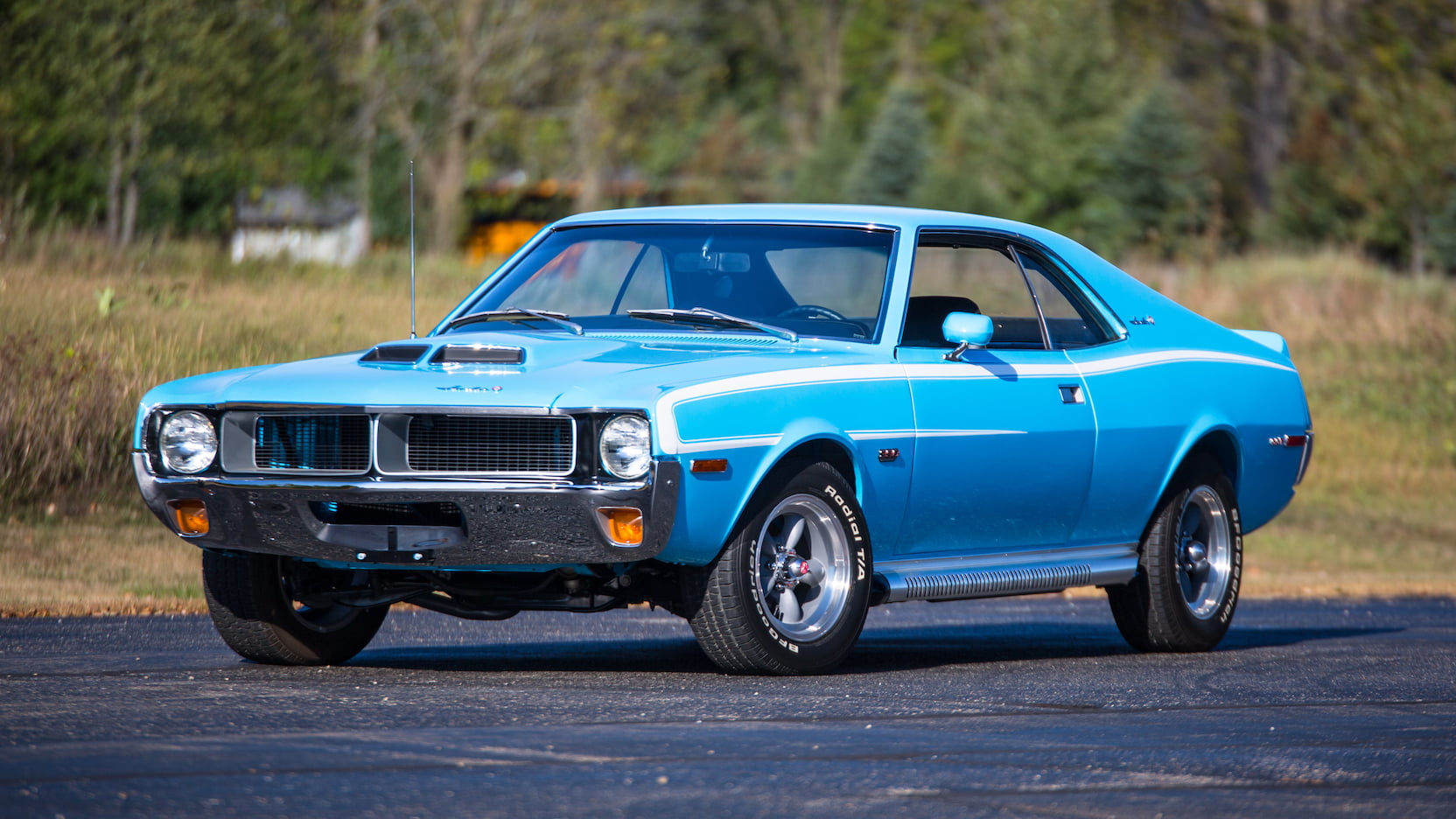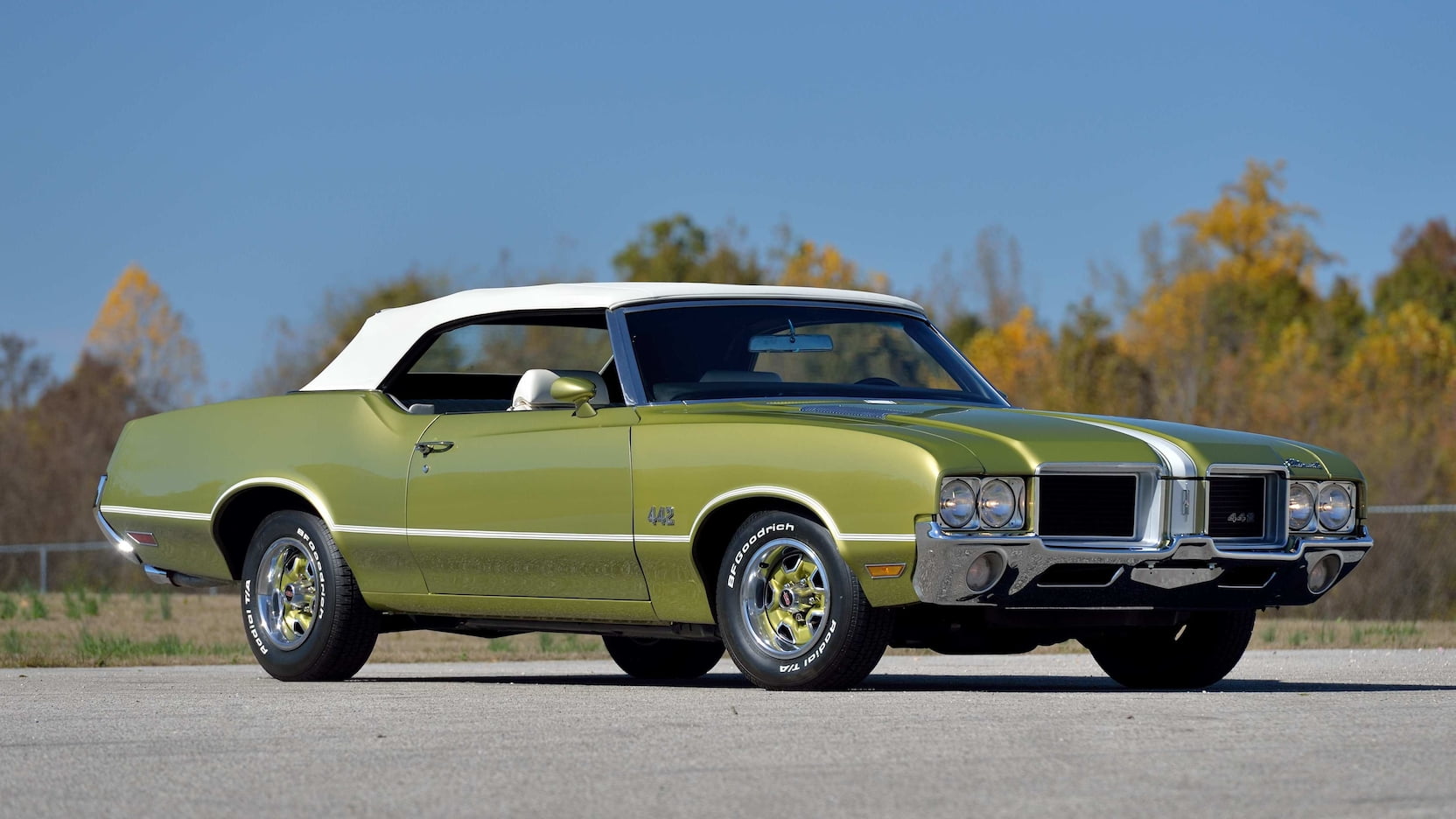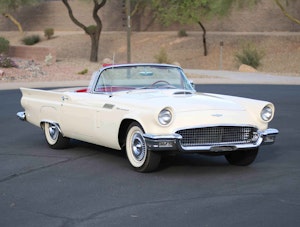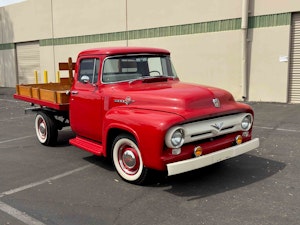Media | Articles
28 little-known muscle car facts
March 6, 2023: Good day, fellow gearheads. There is a lot to report on coming out of the recent festivities at The Amelia, and much of that content features luxury brands and European marques. So we thought we’d treat our muscle fans to an old favorite article (September 4, 2019), lest you think we’ve lost our taste for tire-smoking Detroit iron. -Eric Weiner, Executive Editor
Want to impress your friends? Outsmart some loudmouth on Facebook? Just wanna get in the good graces of a certain tribe? Then take this here list to your local cruise and throw one at every faction under the Ambassador Bridge. Inspired by Steve Magnante’s 1001 Muscle Car Facts, this list an indispensable resource for any aspiring muscle-car know-it-all. In no particular order:
AMC

- Yes, there still are folks who think the 390 commonly found in AMXs is a Ford engine. It’s not.
- An urban legend suggests that the Trans Am-inspired 1970 Mark Donohue Javelin built with the standard 360 received stronger internal webbing (a feature of the 390) than run-of-the-mill 360s, but there’s no evidence of a special 360 having been factory-installed. AMC expert Ian Webb offers an explanation: AMC offered a service block with the aforementioned reinforcements but with the smaller bore of the 304 that is colloquially referred to as the “Trans Am block.” It is still unsubstantiated that this block was installed at the factory.
Buick

- The 1968-69 GS California was based on a regional model built in 1967. Interestingly, all were based on the Special series and not the Gran Sport.
- 1966 was the only year that there were three Gran Sport series: Skylark, Riviera, and Wildcat.
- The last year for an available four-speed for full-size cars was 1965.
Chevrolet
Marketplace
Buy and sell classics with confidence

- It was possible to order a 1966–67 Chevelle with the 396 that wasn’t an SS 396. All you had to do was visit a Canadian dealership and order a Malibu coupe or convertible with the A51 package. It was called the “Sports Option” and included Strato-bucket seats, console (when paired with four-speed or automatic), rocker trim, contrasting rear cove trim (for 1966), and Malibu SS identification. An A51-equipped Malibu was the only way to score the 396.
- “Band-Aid” stripes for 1967–69 Camaros were an exclusive Z/28 feature. Exceptions: 1969 Z11 pace cars and the Z10 hardtop promotional model.
- For the 1968–69 Camaro SS and Nova SS, the L78 396/375 was more popular than the L34 396/350.
Dodge

- The Dodge Dart Swinger 340 was only available in 1969–70 in the U.S. but, due to the efforts of two dealerships, a handful of special-order Dart Swinger Specials with the 340 were available through 1972 in Canada.
- For 1970, if you wanted a 340 in a Dodge Challenger, you ordered the base model. In 1971, you could get the 340 in the Challenger or Challenger R/T.
- The 1969 Dodge Charger Daytona’s nose was made of sheet metal, not fiberglass.
Ford

- In 1971, the 429 Cobra Jet Mustang was the only Ford Motor Company product that officially offered the Drag Pack.
- The 429 Police Interceptor for 1971 full-size Fords was similar (but not identical) to the 429 Cobra Jet, including heads and camshaft.
- Despite the name, the 429 Cobra Jet was not standard for the 1970 Torino Cobra.
Mercury

- Ram air was not available with the 428 Cobra Jet for 1969 Mercury Montegos—only the Cyclone was available with air induction.
- The 1969–70 Marauder X-100 could have other contrasting rear two-toning besides matte black. It also was optional for the base Marauder.
- Mercury generally used the same engine codes in the VIN as did Ford but, for 1970, both the 428 and 429 Cobra Jet with ram air was designated differently by Mercury.
Oldsmobile

- Besides the Corvette, the 1971–72 Olds 4-4-2 was the only GM vehicle that offered a dual-disc clutch.
- The 4-4-2 package went from being based on F85 and Cutlass models in 1966 to the fancy Cutlass Supreme in 1967.
- The 1970 Cutlass SX had a confusing array of available engines: L33 2bbl. 455/320 was standard through March, replaced by the L31 4bbl. 455/365 from the full-size series. The W32 455/365 (the same engine standard on the 4-4-2) was optional throughout the year.
Plymouth

- Both the side stripe for the 1970 Duster 340 and the optional “Hockey Stick” stripe for the 1970 ‘Cuda were only available in black from the factory.
- Three Barracuda models were available with the 340 in 1969: standard, Formula S, and ‘Cuda 340.
- Strangely, the standard engine for the 1970 Sport Fury GT was not the same 375-horse 440 found in the GTX—it was the 350-horse version of the big-block.
Pontiac

- Black grilles were not a part of the Judge package for 1969. Rather, all ram air cars received black grilles. Since all Judges are ram air cars, black grilles have long been associated with the Judge.
- The last full-size four-speed was in 1968. Only 755 were built, with most being Catalinas according to the GM Heritage Center.
- All of the 1969 Grand Prix Model J’s four-barrel engines were available with a standard three-speed. The Model SJ shared some of the same engines but required a four-speed or automatic.
Shelby

- The initial run of 1967 Shelby Mustangs had driving lights in the middle of the grille. However, some states had rules on the close proximity of lights, so Shelby made a running change and later cars received lights at the outer edges of the grille.
- Ford’s Grabber colors got their start with the 1969 Shelby Mustang.
***
Check out the Hagerty Media homepage so you don’t miss a single story, or better yet, bookmark it. To get our best stories delivered right to your inbox, subscribe to our newsletters.










Impress your friends with this one…….in 1969, a brand new Mach 1 Mustang was sold in Beaumont, Texas to some guy named Lenny.
you could order a 69 (maybe other years also) chevelle ss in a 300 deluxe 2 dr. sedan instead of the malibu hardtop
you could order a 69 chevelle ss ( maybe other years also )on the 300 deluxe 2 dr. sedan instead of the malibu hardtop
I thought the Drag Pack was also offered on the Mustang Boss 351 in 1971, anyone else?
Nope.
I thought the Drag Pack was offered on the Mustang Boss 351 and the Super Cobra Jet Torino Cobra for 71.
The only recipient for the Drag Pack in 1971 was the 429 CJ Mustang.
Outstanding article! Really enjoyed this one, not a ton of unneeded content to sift through, just the fact’s man. My compliments to the author!
In what category does the Cutlass fall?
Muscle car.
Even one with a six?
How about a mid 60’s full size Pontiac with a 409 and 4 speed. They were manufactured at GM’s Oshawa Ontario plant. The plant also made Chevrolets so it was less costly to use the 409 than have a small volume of 421’s sitting around. At least that was the story.
Quite an interesting article, but there was very little there I didn’t know. Post some stuff about the last of the Muscle cars. While some or most may not agree, the Muscle Cars lived on through the 70s and early 80s. Anytime you could get a 454 in a Corvette, Chevelle or even a Full Size, or a SD 455 in a Trans Am or a Formula, or an HO in same like a 73 GTO or a Gran Prix/ or I could go on and on. The main difference in the later cars was the fact that one had to either be a Mechanic, have Mechanical knowledge or be affluent enough to pay someone to modify the stock engines to produce 60s power levels. It wasn’t hard. I had a 77 400, 4 speed Trans Am in 1980. Put on Headers, 2 1/2 duals, mid range Cam and worked over the Quadrajet. It would eat any car of it’s time alive as well as a 69 Coronet 440, 4 speed. Wasn’t a Dragstrip in my area at the time so I can’t publish any times, but having had about 30 cars since, as well as a whole lot of Big Block Chevs, Firebirds, Corvettes, Caprices etc. I can assure you that car was fast.
You must have been a really good driver? I believe a 1977 400 put out about 200-210 HP at the crank with about an 8.2 or so compression ratio? Even with the cam, headers, exhaust & q jet work you might have added maybe 75HP – 100 HP or so at the crank which still only puts you at maybe 250HP at the wheels max. I would have liked to have raced you with my 80 Z28 with only 180HP at the crank after putting smaller 64 cc heads, cam, headers, exhaust, carb work and distributor work which ended up with about 350-375 wheel hp now that was quick but still not fast!
I just loved it when the TA 400 and SD455’s would pull up. They all thought I have nos.
Anyway great informational article. Really loved all the cool info. Thanks
In 1968, if you ordered a full dive Chevrolet Impala with the SS427 package, you got a bench seat, not the bucket seats for the front. Also if you ordered it with a Turbo 400 transmission it was column mounted not floor mounted. That happened to my cousin. I had warned him that it needed to have both the SS427 and the SS OPTION To get the floor shift and bucket seats. He had to have the dealer order another car when the one without the bucket seats and floor shifter came in because they guaranteed it was going to have the SS package. It took them three months to sell that car.
Meant to add I still own my SS 427 Impala that I special ordered from Dana Chevrolet in 1968.
Got the list – NOW what I need is that Delorean time machine (or that ‘hot tub’ time machine), so I can go back in time to order and buy some of these cars, with the ‘special’ options..
Great read. I passed on a Swinger 340 in the mid 70s as well as a 70 Z28. 50k miles and a little bit too much smoke out of the exhaust pipe on the Z. Regret passing on both but 2k was a lot of money back then. And another one beside a gas station 70 Cyclone 428 with 100k for only 900$. I never had the space to store them living in the Boston area with snowy winters. Glad I did save a few bikes instead. Started restoring the 73 550 Indy 2 stroke. I did manage a 13.5 time slip at NE Dragway a long long time ago. Also 81 CBX and a 97 Valkyrie. I think of them all as hot rods with 2 wheels and easy to store. Sorry I got way off track. D
Great article! Very informative and useful, especially if you own any of these cars. If you have added anything to your car(s) that makes you happy and someone walks up to your car at a show-and-shine and starts annoying you with uninvited criticism, you can say, “I know. I read Hagerty too.”
First Muscle car? I vote for the 1963 Tempest Lemans with the 326. This car is under appreciated compared to the (great) 1964 GTO.
In 1967 you could get an Impala 427, not being an SS with the phony chrome pots in the middle of the hood. And I asked for a dark green body paint either Olds or Cadillac green and black Vinyl roof, but a gold interior….GM did colors like that from other GM cars for a $35.00 one time charge. the dealer figured $300 but lost. A local used car guy used to buy hot Pontiacs and Chevys to street race the teenagers with and he always got a special color….The good old days